Sustainable/Impact Investing] Building for Planetary Renewal - Urban Sequoia (A lecture by Mina Hasman, Sustainability Director at SOM)
Urban Sequoia by Mina Hasman. Exploring how architecture can move beyond sustainability toward regeneration—where buildings act like trees, cities function as living ecosystems, and design, capital, and climate innovation converge to create a low-carbon, resilient future.
![Sustainable/Impact Investing] Building for Planetary Renewal - Urban Sequoia (A lecture by Mina Hasman, Sustainability Director at SOM)](/content/images/size/w1200/2025/10/Screenshot-2025-10-30-221501.png)
Hi All,
Imagine if every building acted like a tree—absorbing carbon, cleansing air, and giving more back to the planet than it takes. Urban Sequoia reimagines cities as living forests, where architecture becomes a catalyst for regeneration, not just resilience. That is Mina Hasman and SOM's vision. A workable solution today and not tomorrow.
I had the pleasure of attending Mina Hasman’s lecture at the Architectural Association (AA) amid the Halloween excitement in Soho, London. The evening brought me back to my university days—surrounded by students, sketches, and the restless optimism of future architects and urban designers.
When I was at NYU, I took a few courses in urban design and architecture, fully expecting to become an urban designer—someone who could help cities redistribute resources efficiently and equitably. I was, and still am, deeply drawn to the idea of making the world a better place. Back then, I carried that mission with a kind of solemn intensity, as if the entire weight of the world rested on my shoulders.
Life, of course, had other plans. I entered finance instead. Yet the fascination never left. So, wherever I go, I still read cities through their buildings—their skylines, their city layouts, their vibes, their air, their materials, their light, their massing, the logic of their streets that either enable or constrain human life.
From an investing and capital-deployment perspective, green urban spaces and high-performance buildings are no longer optional; they’re core assets in the transition to a low-carbon economy. That’s why today’s talk felt so timely. In a world of accelerating climate risk, architecture can move beyond damage control. The built environment can become regenerative infrastructure—capturing carbon, restoring ecosystems, and building resilience from the module to the district to the metropolis.
This is the paradigm that excites me: materials innovation, ecological design, and climate-responsive urban systems working in concert to create places that produce energy, purify air, and advance social equity. In this vision, cities evolve into active carbon sinks and productivity engines—woven seamlessly with natural systems and aligned with human wellbeing. It’s not merely a response to crisis; it’s a creative brief for the next era of investing and design—environments that heal, empower, and endure.
There was also an interesting question raised by an student about the extractive nature of “green” building materials and minerals—the supply chains and displacement of Indigenous communities involved in sourcing the critical minerals needed for sustainable buildings and cities. I don’t have a clear answer, but I was glad to hear these questions raised by students and fellow practitioners. It’s important to understand their viewpoints as a steward of capital, because these are ultimately collective decisions.
My questions for you: How can capital help turn our cities into living, regenerative ecosystems rather than carbon-intensive assets?And what would it take for architecture, engineering, and finance to collaborate at the scale of planetary renewal?
*Check out her work in the video below and the arch daily article for more info.
Core Thesis
- Cities as the lever: Though cities occupy a small portion of land (3%), cities drive ~75% of global annual GHG emissions. That makes them both the main problem and the best platform for solutions.
- Shift in mindset: Move from “optimizing single buildings” to designing buildings as active components of urban ecosystems—akin to trees within a forest—so cities function like interconnected, carbon-absorbing systems.
- Discipline upgrade: Architecture must evolve beyond form/function to ecological stewardship—rooted in care, regeneration, and long-term responsibility (100–200-year horizons).
Why this matters (context)
- The climate crisis shows up in cities via heat, infrastructure stress, and social inequities—signals of intertwined ecological, economic, and social breakdown.
- Holding 2°C (1.5°C is now “barely mentionable” in the talk) requires whole-economy transformation. Built environment is “a small sector, but with the broadest physical surface area,” so decisions here have outsized system impact.
The Urban Sequoia Concept
- Analogy: Buildings as “sequoias” connected through roots (infrastructure and policy) to form urban forests.
- Goal: Go beyond net zero—carbon-absorbing buildings and districts that actively improve air quality and act as carbon sinks over their lifetimes.
- Menu, not one-size-fits-all: A flexible toolkit deployable across contexts (new build, deep retrofit, low-rise/high-rise, different climates and cultures).

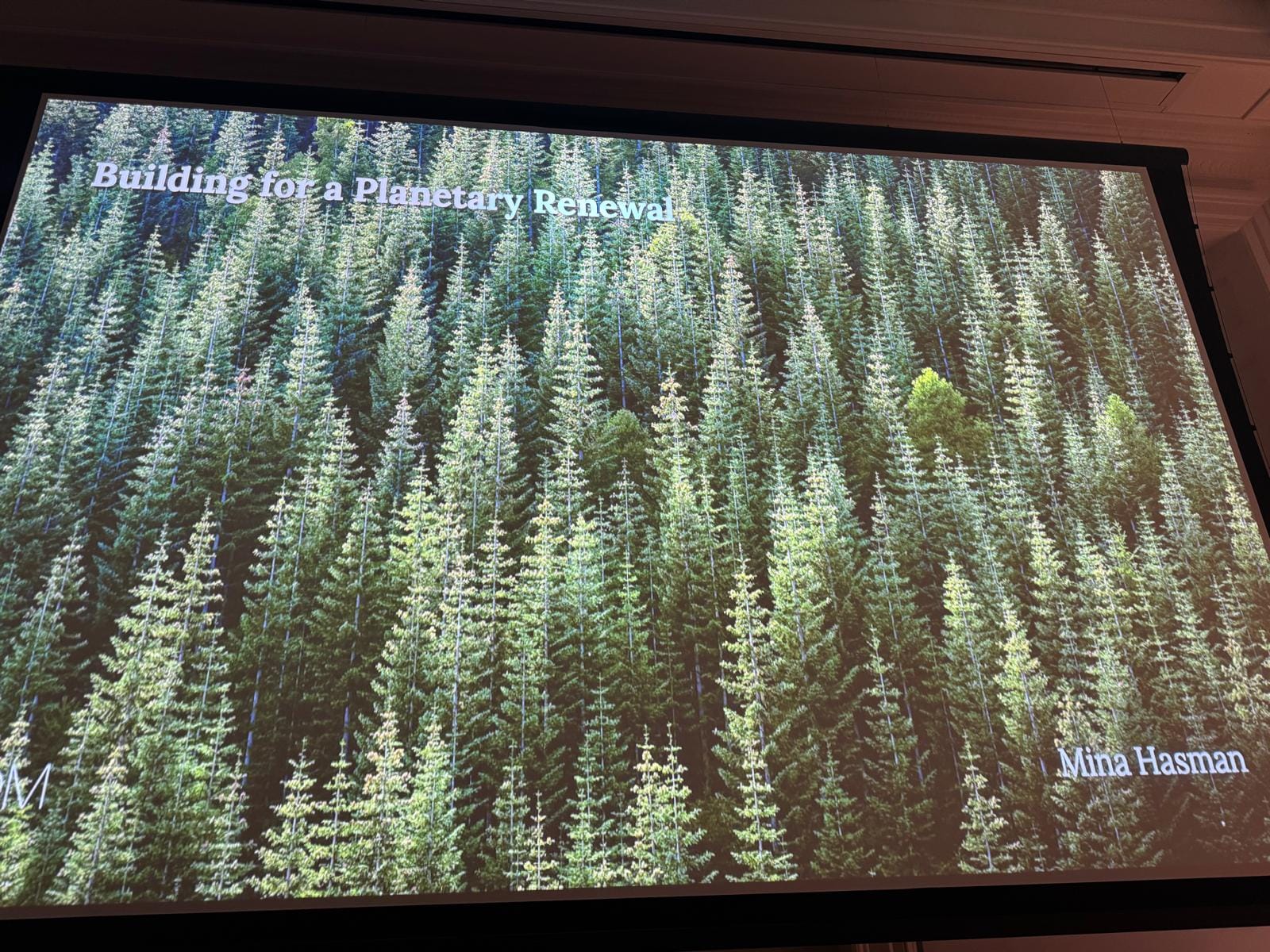
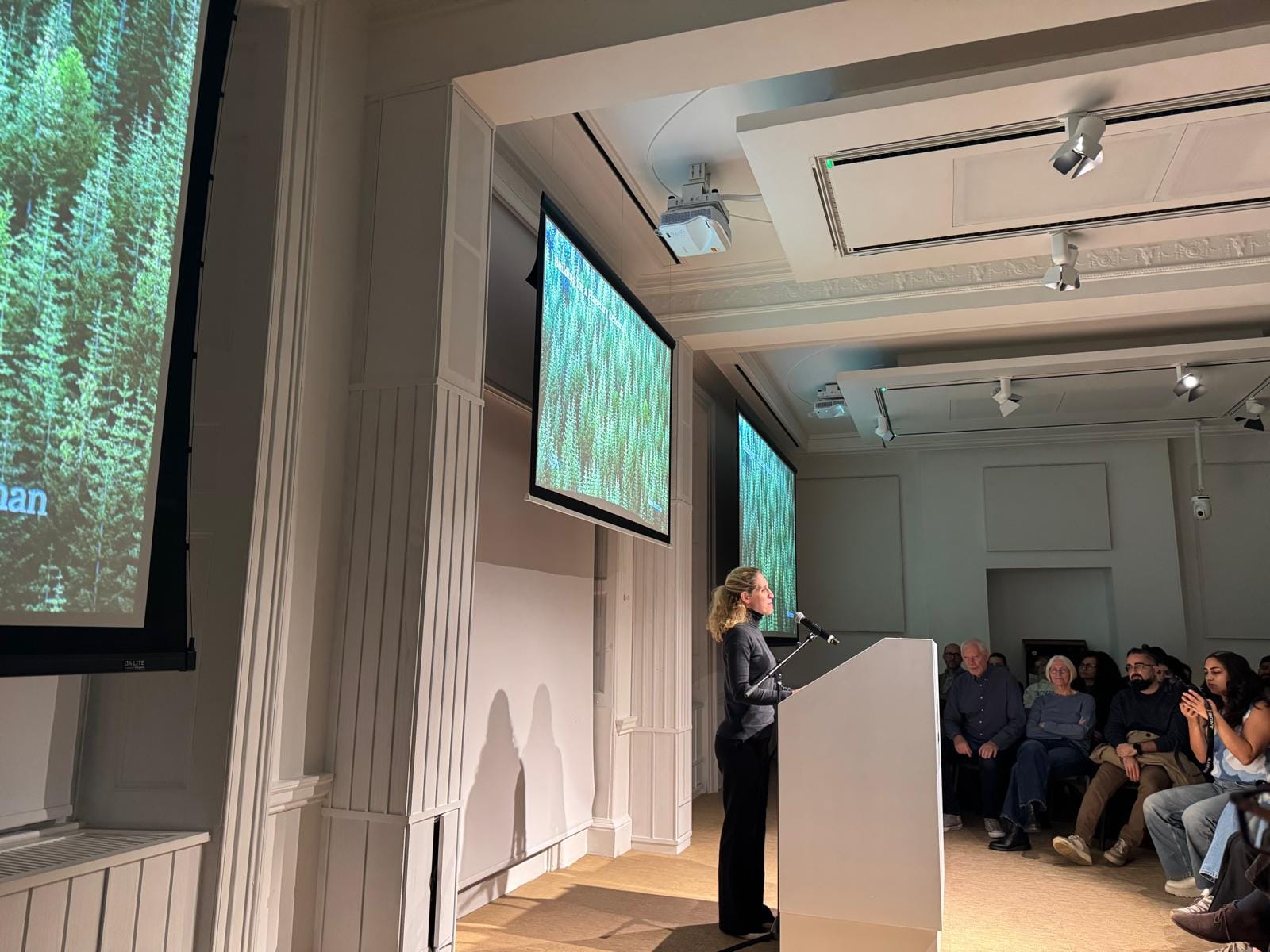


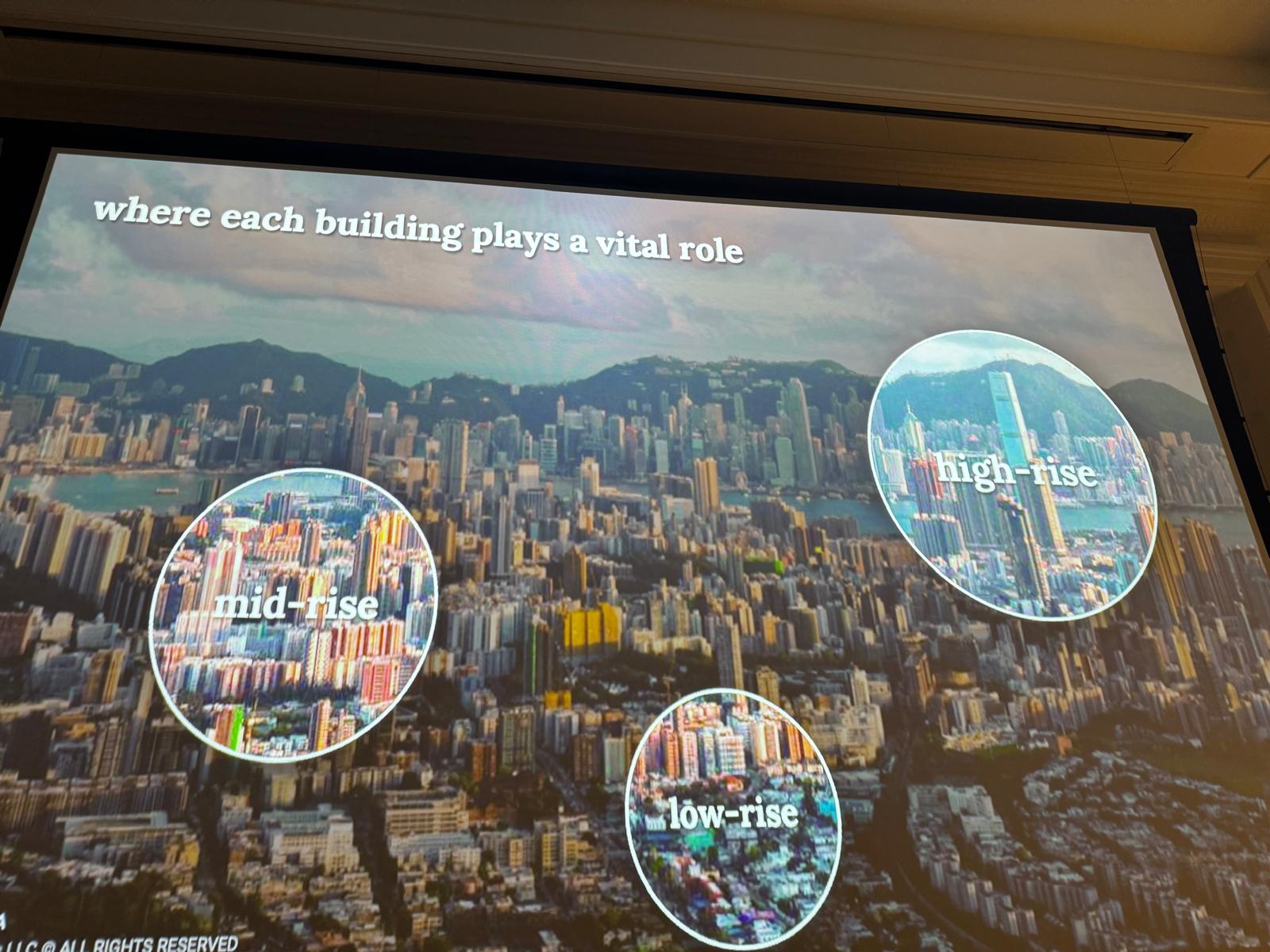
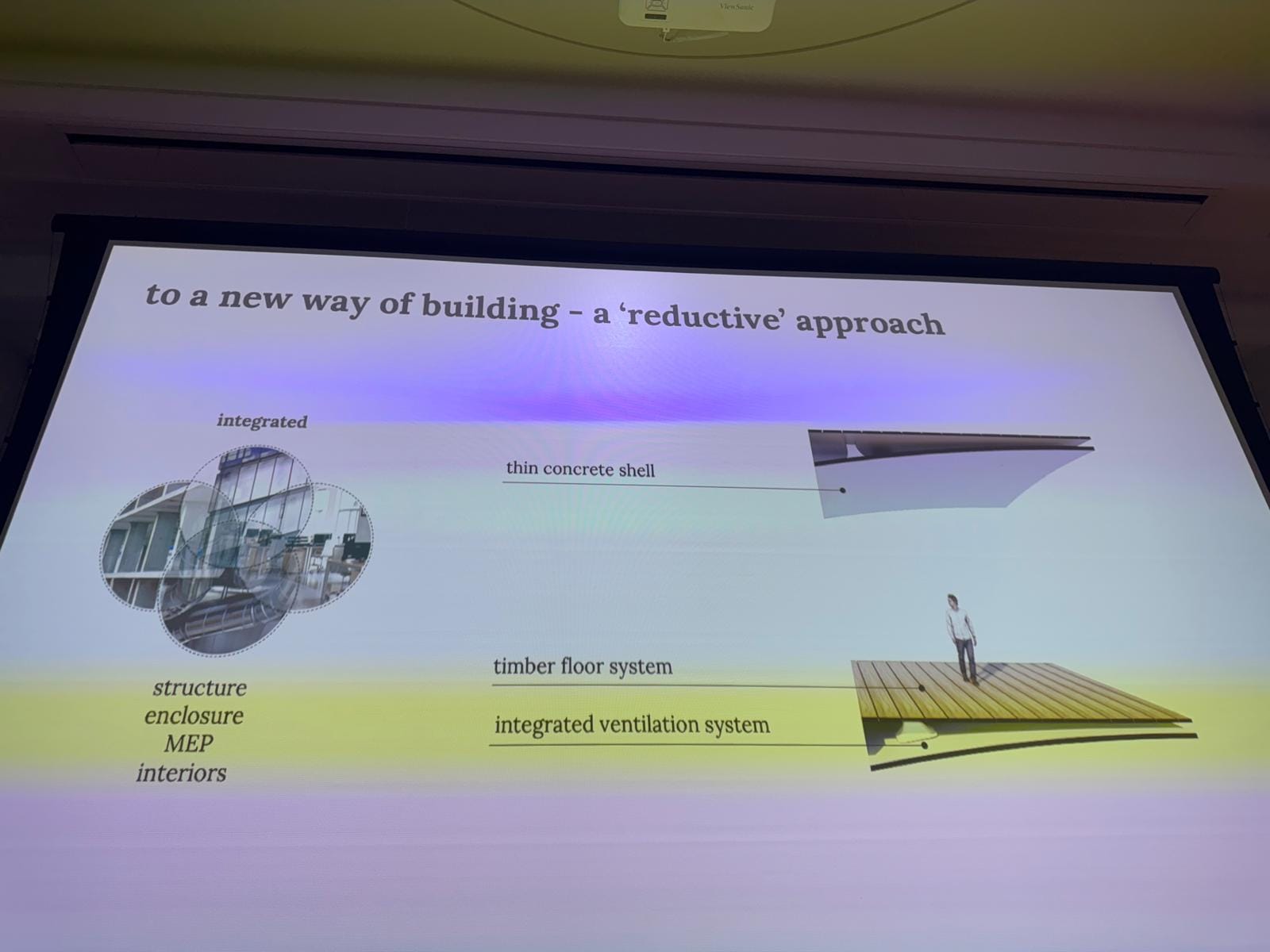


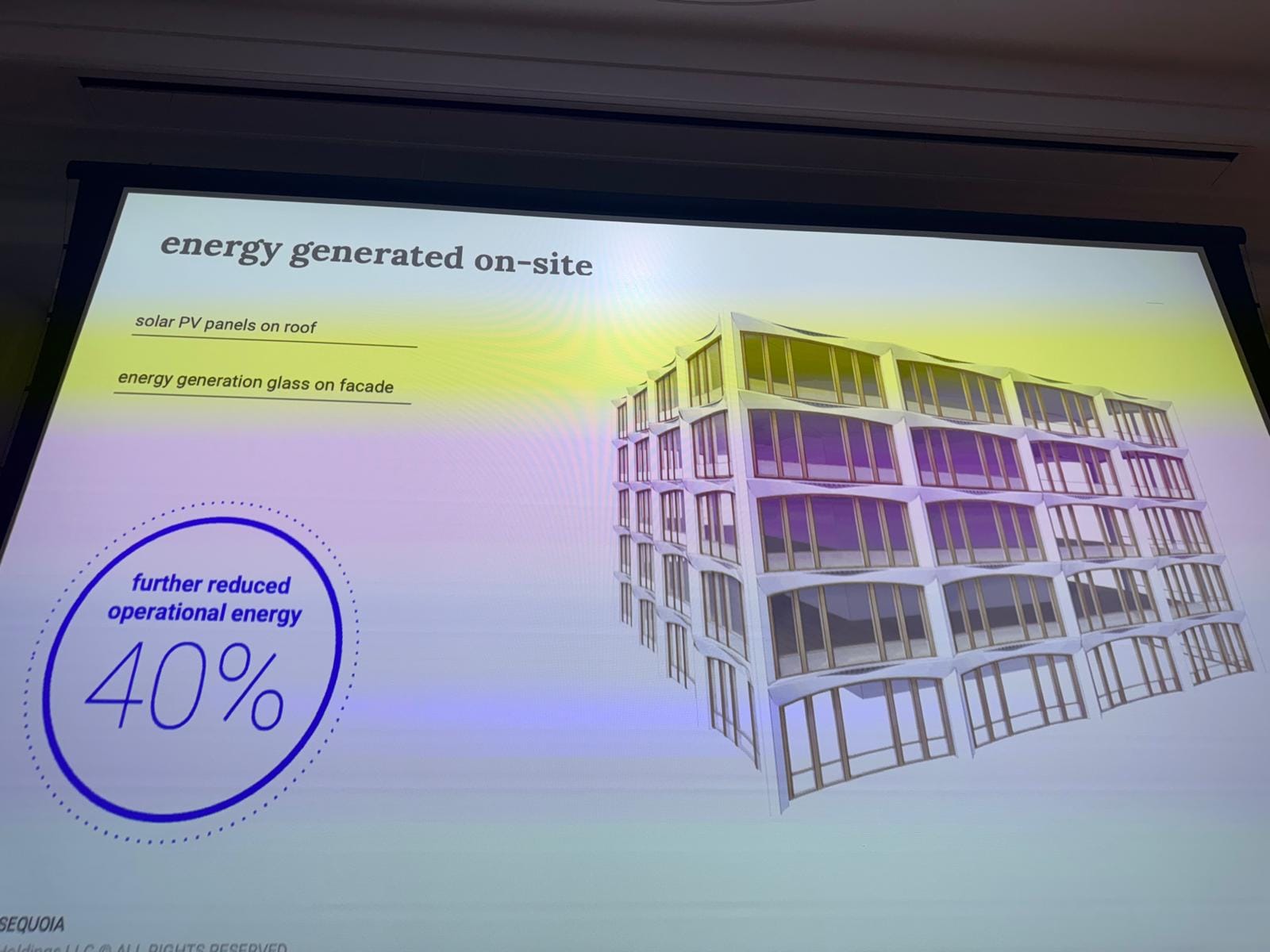
How it works (design + engineering moves)
- Integrated, reductive construction logic
- Replace the additive, layer-on-layer model (structure → façade → MEP → finishes) with integrated assemblies that do more with less.
- 9×9 m module: consolidates services between a thin concrete slab and a lightweight timber floor/ceiling assembly; prioritizes spatial efficiency, flexibility, and material minimization.
- Myth buster. We don't need new technology for net zero: up to ~90% whole-life carbon reduction today can happen through the current intelligent integration and today’s off-the-shelf tech.
- Carbon-smart materials
- Use bio-based concretes / low-carbon cements and other next-gen materials to cut embodied carbon at source.
- Emphasis: many gains are possible now, even without waiting for new tech.
- Energy-generating enclosures
- Treat the façade as productive skin: PV in glass, spandrels, and opaque elements; roofs fully solar-enabled.
- Claimed impact: ~40% reduction in operational energy/carbon from on-site generation.
- Nature-as-infrastructure (sky gardens + passive systems)
- Sky gardens double as social spaces and air pre-filtration zones; precondition outside air and reduce mechanical loads.
- Form/orientation harness prevailing winds; the building “channels” air to a central core where capture tech sits.
- Claimed impact: up to ~75% reduction in operational carbon via reduced mechanical reliance + passive design.
- Embedded carbon capture
- Direct-Air-Capture (DAC) modules scaled down and integrated into the core; the captured CO₂ can be sold to industrial users (e.g., pharma, materials).
- Claimed potential: building performance beyond net zero—~2.3× carbon-negative, and (over a 100-year horizon) approaching ~3× carbon-negative, depending on assumptions.
- Longevity + adaptability
- Structural grid/heights support program changes over time (office ↔ residential ↔ hospitality), avoiding demolition.
- Design for disassembly ethos: extend useful life, maintain value, upgrade systems as tech improves.
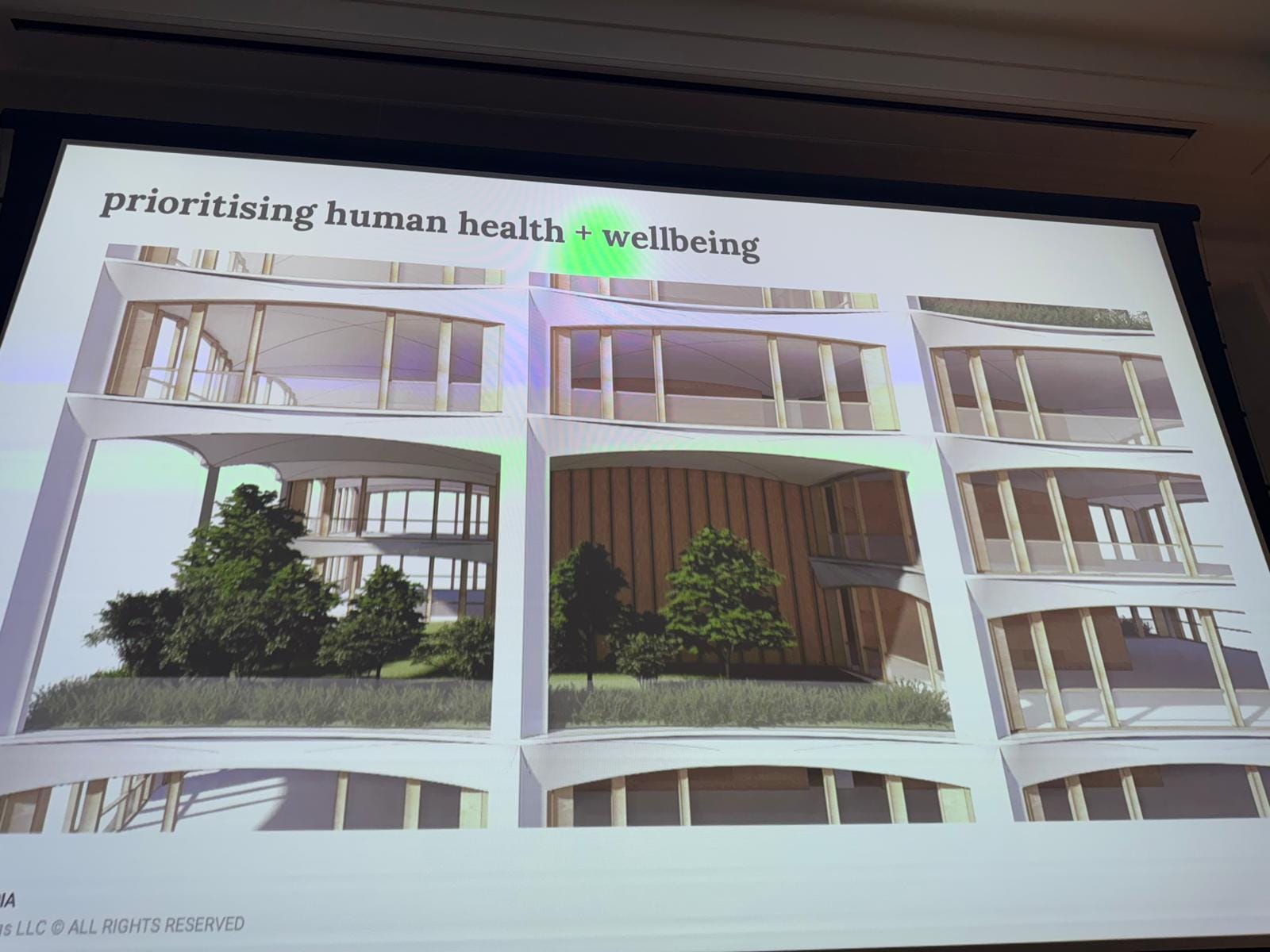
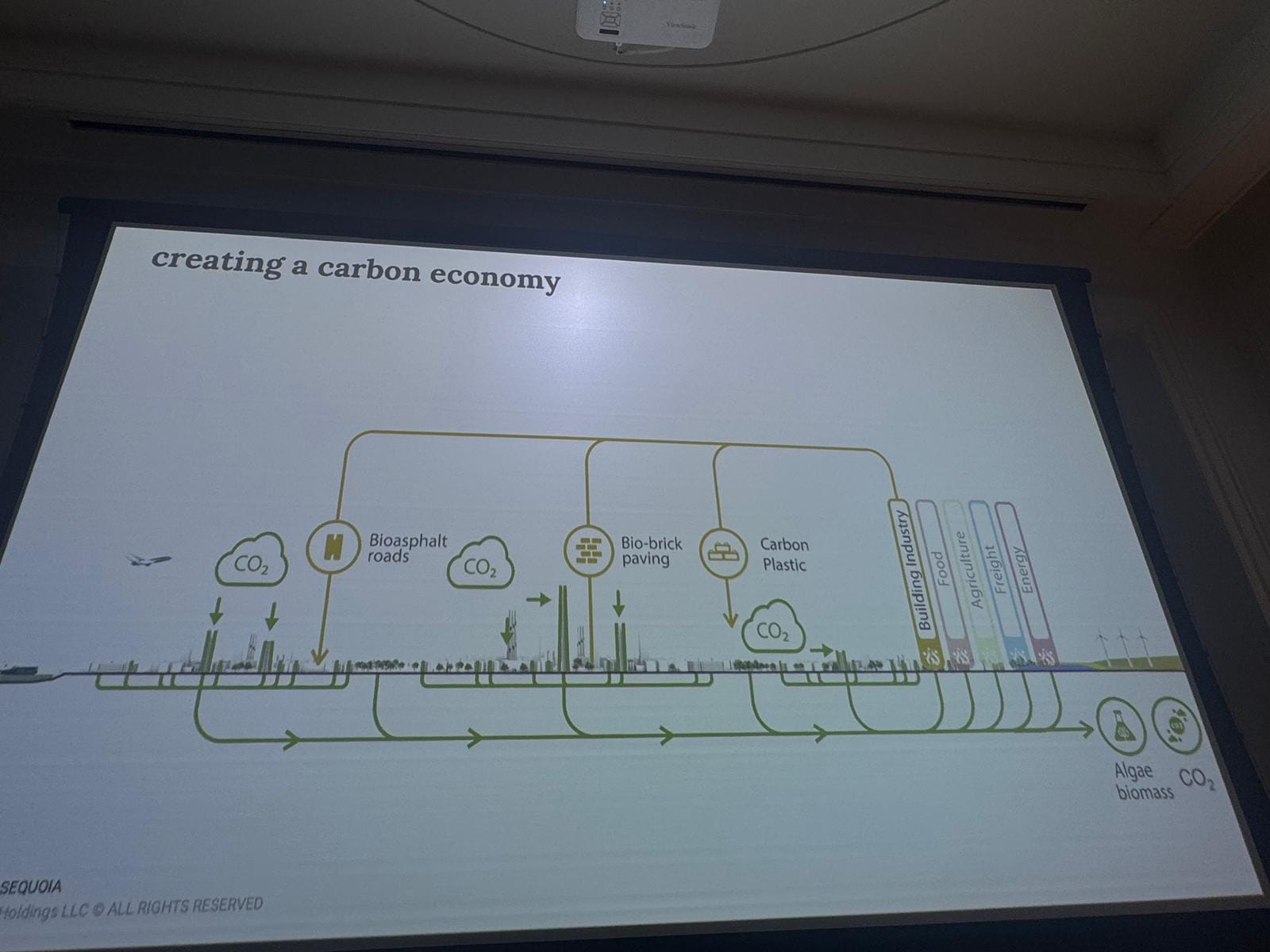
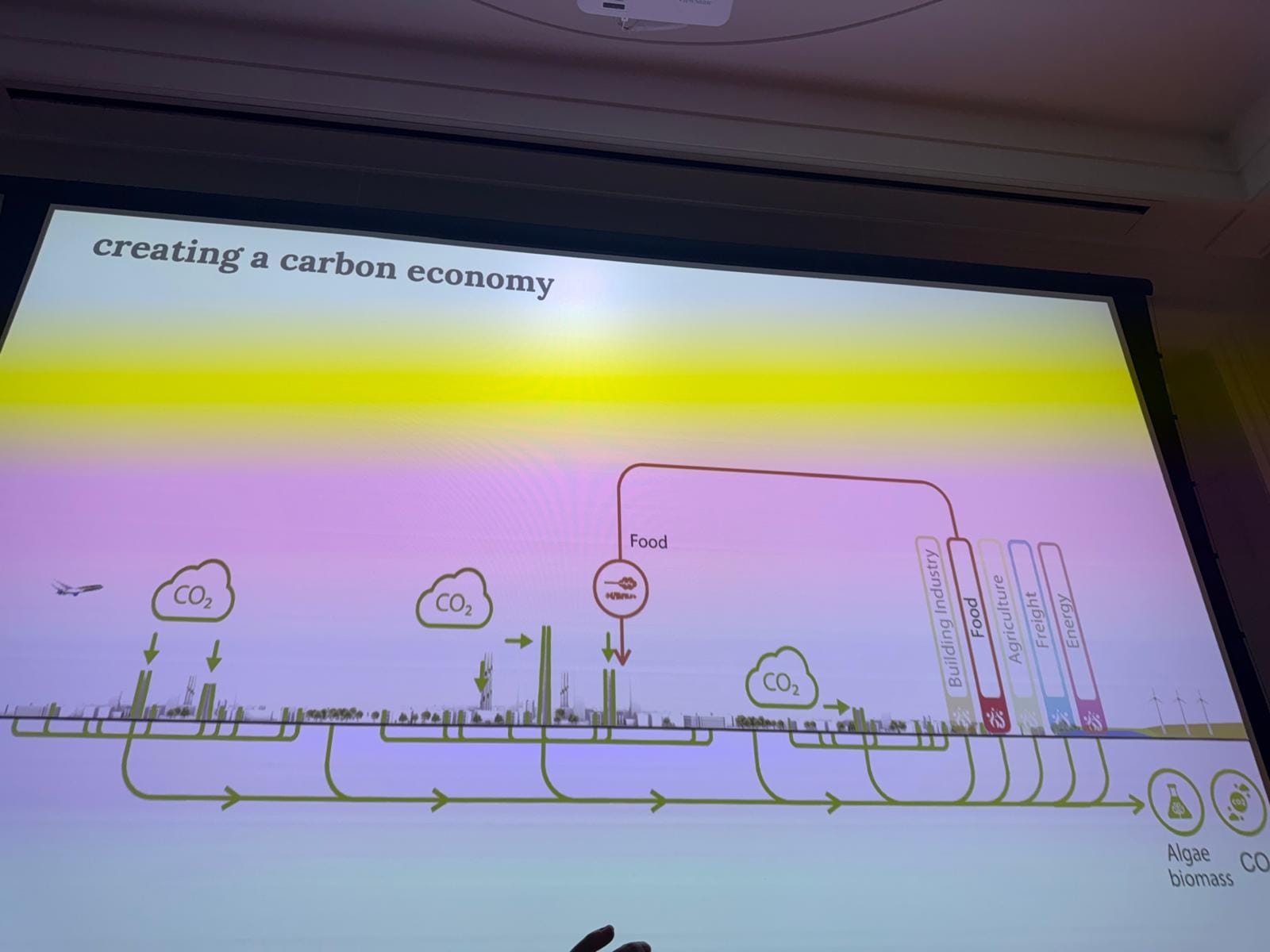
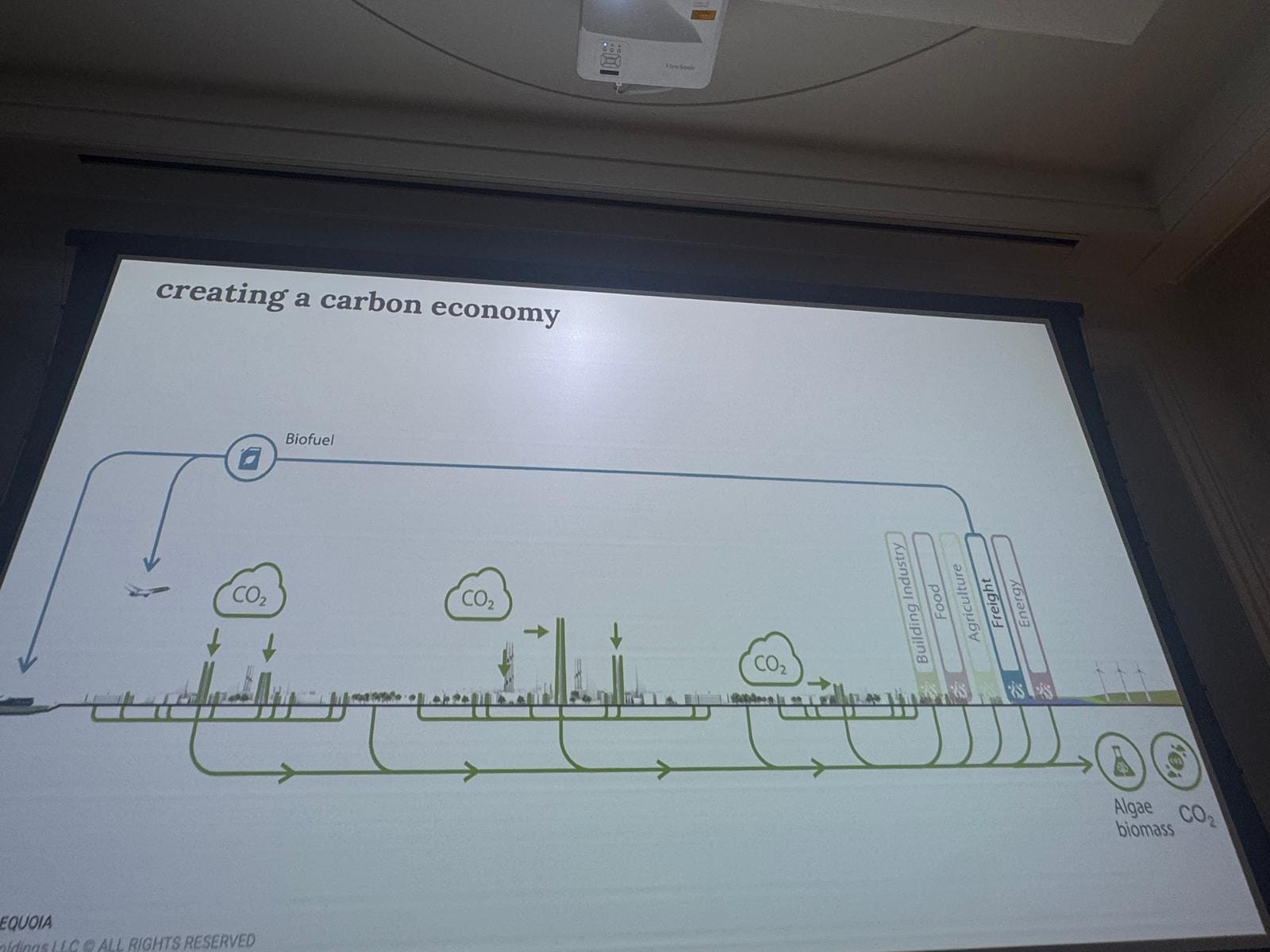
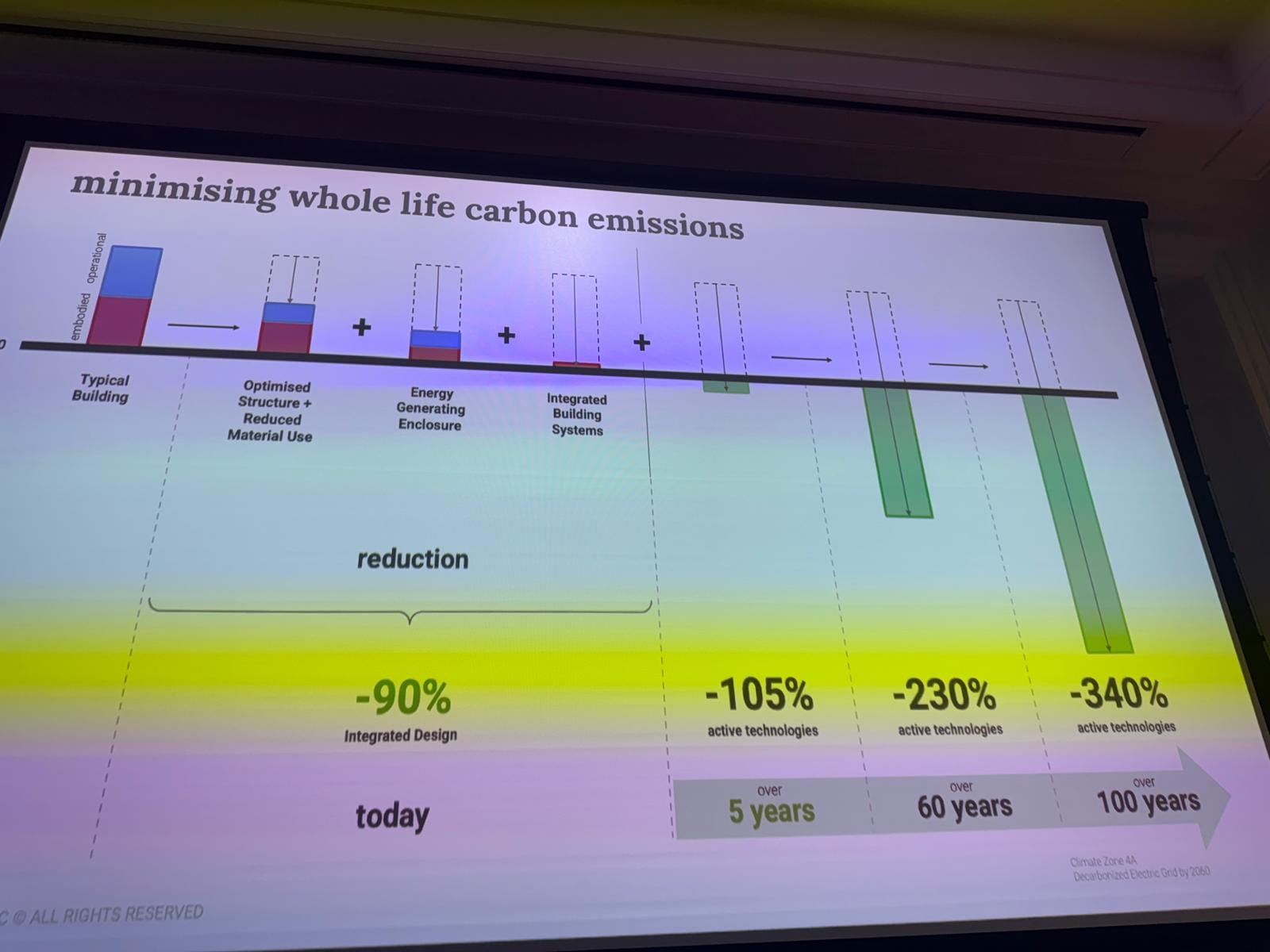
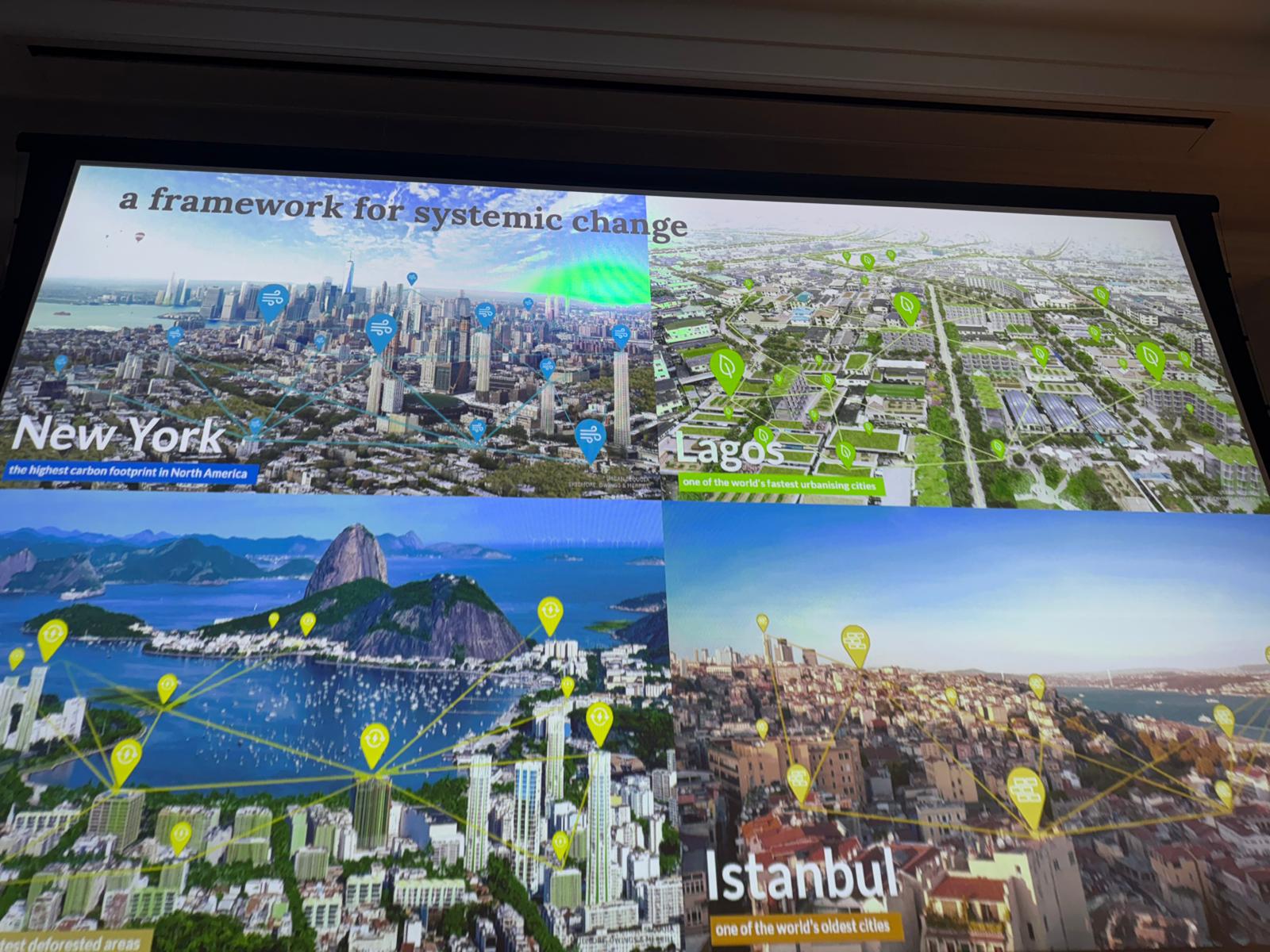
Scaling from building to city
- District-scale strategy: Link buildings, streets, parks into networks for renewable energy, carbon capture, and CO₂ reuse.
- CO₂ as feedstock: Treat captured carbon as a resource (for engineered materials, pavements, sub-grade infrastructure).
- Repurpose legacy networks: Reuse gas lines and existing conduits as CO₂ distribution/storage pathways during the transition.
- Green/blue infrastructure: Intensify urban planting, carbon-sequestering materials (incl. biochar), and biodiversity corridors.
Deployment across geographies
- Dense global cities (e.g., New York): Carbon-absorbing towers retrofit skylines into functional ecosystems.
- Rapidly urbanizing regions (e.g., parts of Africa): Low-rise, high-impact modules optimized for climate and local supply chains.
- Legacy/heritage contexts (e.g., Europe): Integrate carbon-conscious strategies without erasing historic fabric; retrofits prioritized.
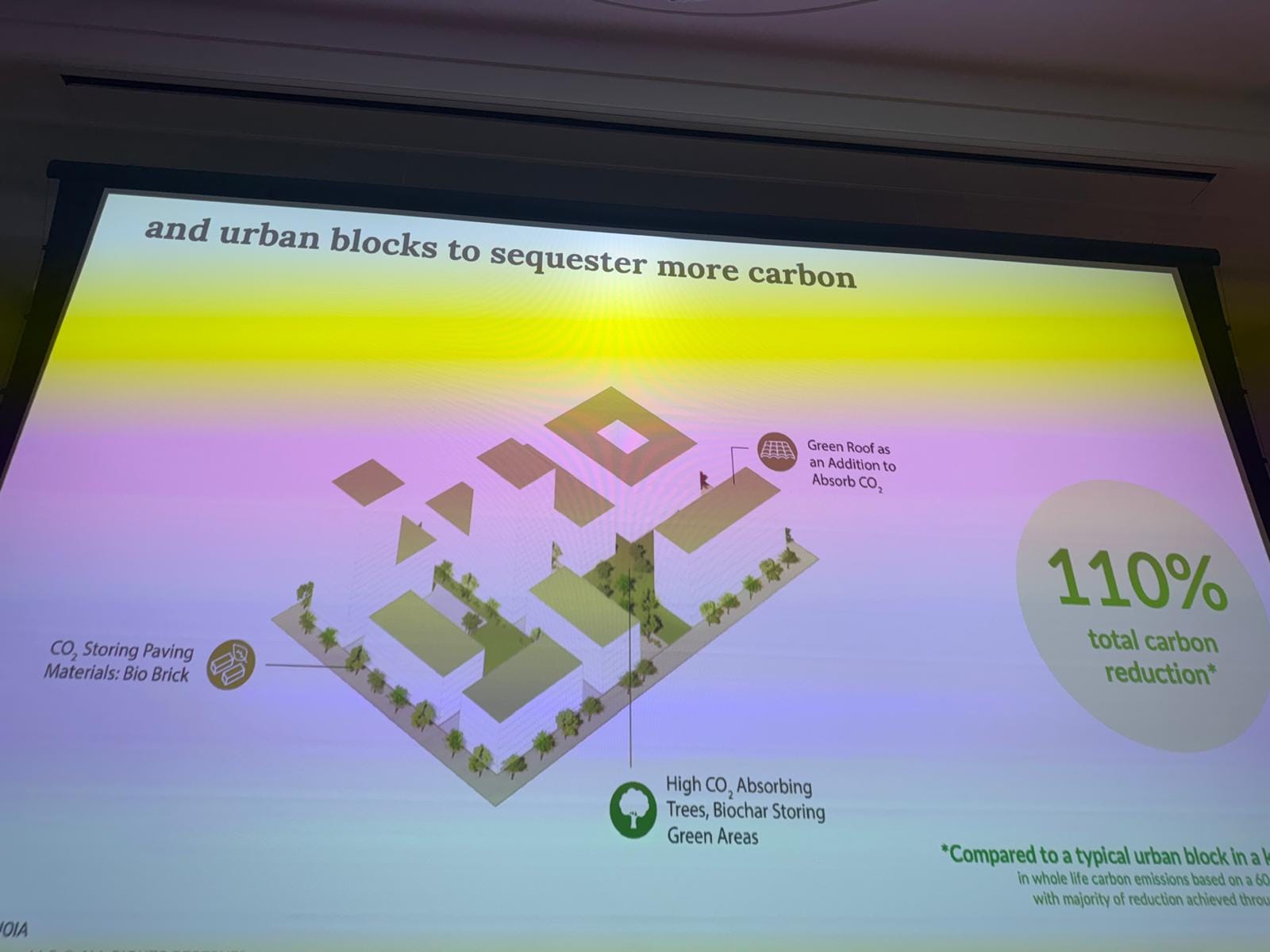
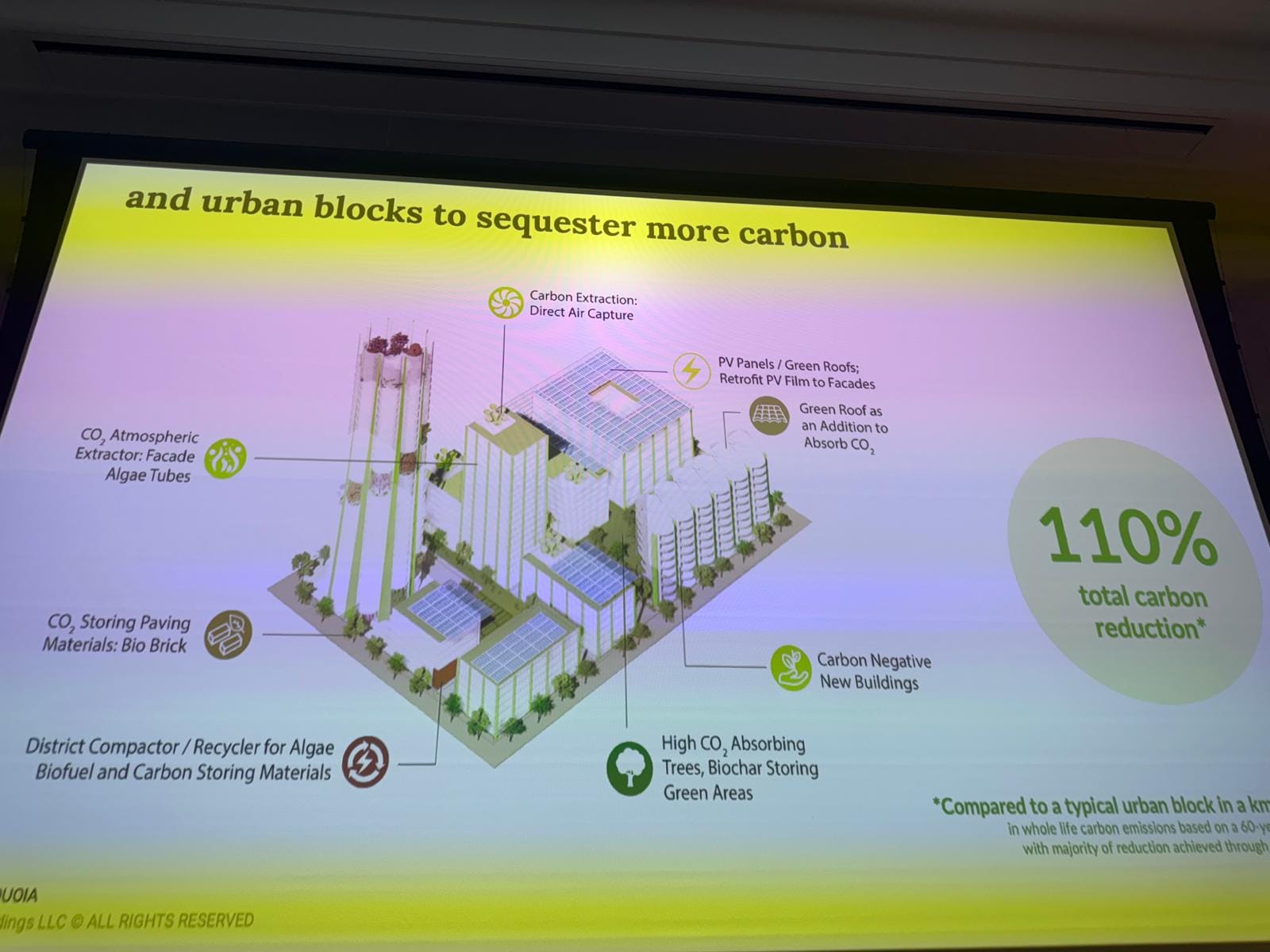
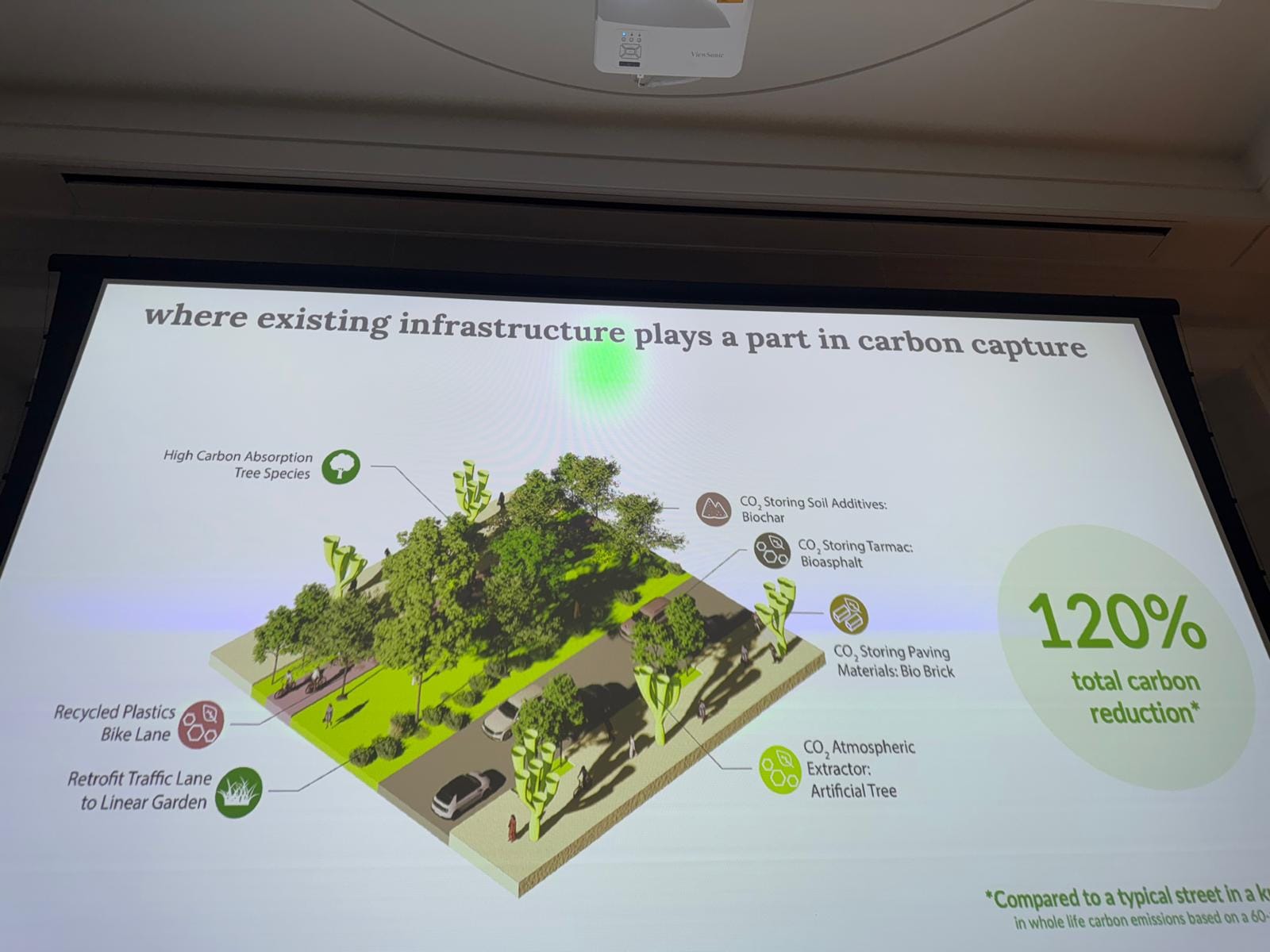
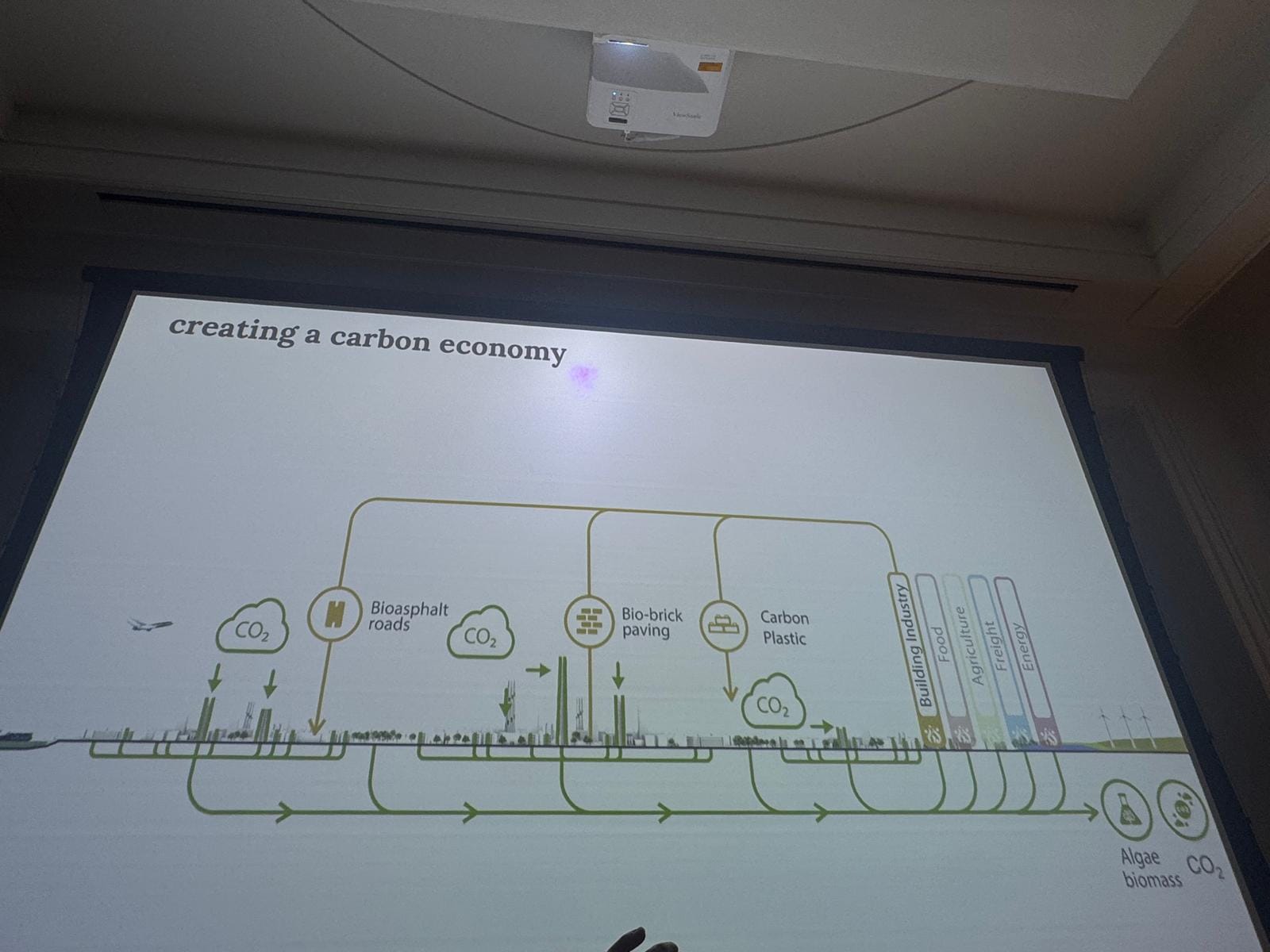
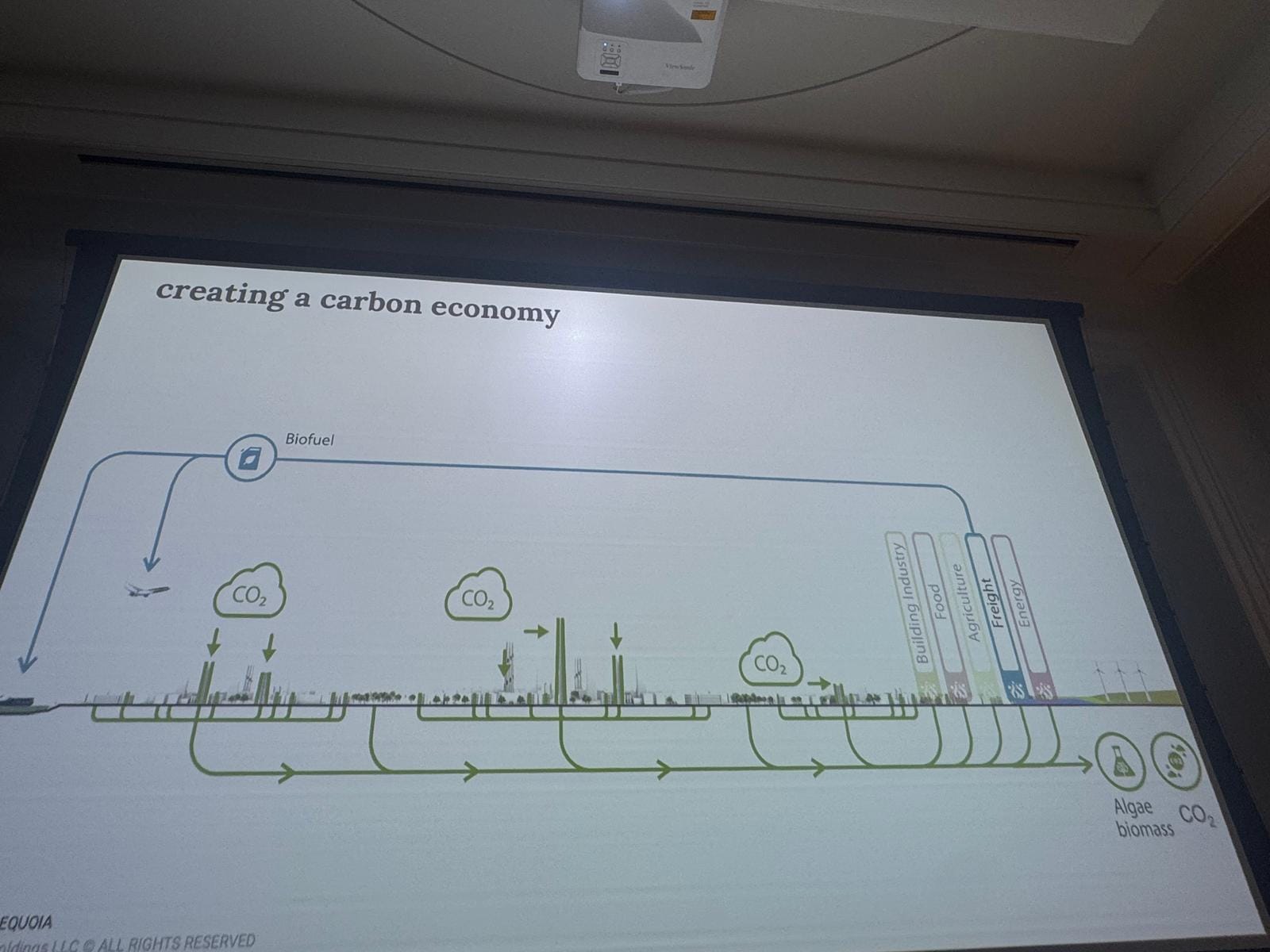
Policy, capital, and delivery (from the talk + Q&A)
- Regulation & incentives
- Need clear carbon accounting (scope, life-cycle) and regulatory KPIs (e.g., a carbon budget per project) to change developer behavior.
- Public incentives (tax, accelerated permitting, grants) for retrofit first, low-carbon materials, and carbon-productive systems.
- Investor risk & pilots
- Start with modular pilots (e.g., a single floor/module) to prove performance; de-risk via stepwise scaling.
- Retrofit vs new build
- Do both, but retrofit first wherever feasible. Reality check: a large share of 2050 stock is not yet built in many regions, so new-build models still matter.
- Transport vs buildings
- It’s and/and: mode shift (walk/bike/transit) is critical and buildings must become productive assets (energy + carbon).
- Developers’ “new is greener” claims
- These often rely on selective assumptions. Remedy: standardized, audited whole-life carbon accounting embedded in planning and finance decisions.
- Justice, supply chains & true costs
- Strong audience challenge: green build tech can drive mineral extraction, deforestation, displacement in the Global South, while assets in the North reap benefits.
- Mina's stance: must factor the cost of action vs. inaction to society, reform supply chains, and raise accounting/standards to expose externalities. Vision requires pairing design with ethical sourcing and policy reform.
What’s actually new here
- Not a single miracle technology; rather, a synthesis of proven ideas—reductive, integrated construction, productive façades, passive airflow + sky-garden filtration, embedded DAC, adaptable structures, and district-level CO₂ loops—organized into a city-first framework.
Claimed performance markers (as presented)
- Whole-life carbon: ↓ up to ~90% via integrated, material-light assemblies.
- Operational energy/carbon: ↓ ~40% through building-integrated PV.
- Mechanical reliance / ops carbon: ↓ up to ~75% via passive/biophilic ventilation.
- Carbon negativity: Beyond net zero; ~2.3× carbon-negative potential, trending toward ~3× over a century with DAC + grid decarbonization + retrofits.
Key takeaways
- Design brief: Treat carbon as a design currency with a project-level carbon budget equal in weight to cost, schedule, and revenue.
- Delivery playbook: Pilot one module, standardize details, and scale across a portfolio; couple with policy incentives and verified accounting.
- City strategy: Plan for networks, not trophies—ensure each project plugs into a district plan for energy, carbon, nature, and mobility.
- Justice lens: Require responsible supply chains, local capacity building, and community benefit; internalize true social/ecological costs.
Q&A Highlights
- On extractive supply chains & displacement: Audience pressed hard on the mismatch between “green” imagery and extractive realities in the Global South. Response: agree costs are undercounted; need stricter carbon/material accounting, policy, and incentive reform so decisions reflect full societal costs.
- On regulation & investor confidence: Call for clear rules, carbon disclosure/accounting, and incentives to de-risk early pilots (e.g. tax benefits); start small and scale.
- On retrofit vs rebuild: Retrofit where possible; acknowledge global regions that must build new—hence the need for low-carbon new-build patterns.
- On transport vs buildings: Not either/or—mobility shifts plus carbon-productive buildings.
- On developers’ LCA claims to justify demolition: Push for independent, standardized whole-life carbon assessments embedded in planning.
- On flexibility/adaptability: Structural and MEP strategies should allow use-changes over time to avoid demolition cycles.
About Mina Hasman. She leads SOM’s sustainability and wellbeing daily operations and long-term vision and strategy. She oversees the firm’s progress on climate action, as it pertains to its global business operations and projects. With her team, she pioneered SOM’s ‘Whole Life Carbon Accounting’ service, which offers assessment of a building’s carbon emissions through its construction/renovation and lifetime. In her leadership, SOM became the largest, Science Based Target Initiative (SBTi) validated design-engineering firm in the world and achieved carbon neutrality.
Her expertise and years of climate leadership has led the TIME Magazine to identify her as one of the 100 most influential climate leaders in the world. For her contribution to the advancement of industry and academia, she was honoured with an Honorary Doctorate Degree by UCEM, under the patronage of King Charles III. She regularly contributes to the wider climate change and wellbeing debate in her role as tutor at various academic institutions (including the UCL, The Bartlett & Manchester School of Architecture) and as a regularly-invited speaker at many international events. Mina is also the leader of the ‘Climate Framework’ - a global, transdisciplinary initiative, aiming to create a common language around climate change in the built environment context and to unite industry and academia for effective, long-lasting climate action. She is also the author of the ‘RIBA Climate Guide’ - structured around the Climate Framework’s key themes - which equips the built environment professionals with essential knowledge to mitigate the impacts of climate change.
![Sustainable/Impact Investing] Regulations Cheatsheet - State of Play (December 2025)](/content/images/size/w720/2025/12/Screenshot-2025-12-08-073043.png)
![Obsidian Brief] When Money Becomes Software: AI, Stablecoins & Bitcoin — Implications for Sustainable and Impact Investing](/content/images/size/w720/2025/12/Gemini_Generated_Image_dppem0dppem0dppe.png)
![Sustainable/Impact Investing] Carbon Markets 2.0 – From Voluntary to Compliance-Driven Demand](/content/images/size/w720/2025/10/WhatsApp-Image-2025-10-29-at-21.11.45_6f97a5ec.jpg)